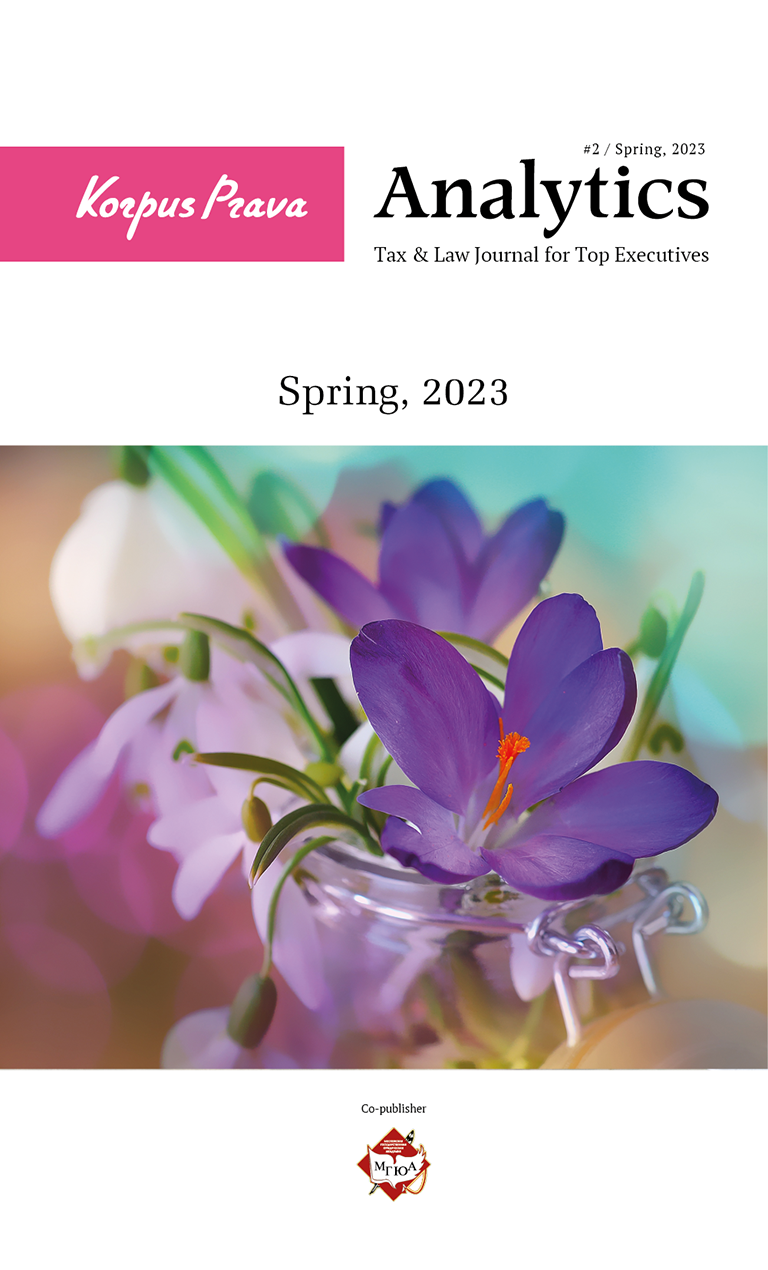Accounting of Transactions with Cryptocurrencies
Cryptocurrency is not money
People tend to emotionally perceive various things and events. The appearance of such substance as cryptocurrency (hereinafter – CC) with such characteristics and features as the exchange rate, ability to be exchanged for fiat money (money with nominal value determined and guaranteed by the state), limited use as a means of payment, creates a sustainable image of CC as money. With no disregard to the above-mentioned CC features, it should be remembered that recognition of CC as money for accounting purposes is possible only upon compliance with a number of criteria specified by the civil law and legislation on accounting (Law on Accounting and IFRS). This article covers issues of CC classification for accounting purposes (Russian Accounting Standards and IFRS), as well the accounting procedure for CC in the Russian accounting.
Firstly, we should clear up some terms. The key issue is whether CC is recognized as money for accounting purposes and preparation of accounting statements.
Accounting Regulation 23/2011 contains no definition of money.
The definition provided by IAS 7 is unsuitable for application. We see the following definition, “Cash includes cash in hand and demand deposits”. It contains neither CC nor non-cash money (even though non-cash money actually forms the major part of corporate funds).
Cash and non-cash money is separately attributed to objects of civil rights (article 128 of the Civil Code of the Russian Federation). Cash money is classified as belongings, while non-cash money as other property.
Article 140 of the Civil Code of the Russian Federation defines money as a legal means of payment, but provides no full list of its features.
Therefore, in order to be recognized as money CC should be a legal means of payment.
In the Russian Federation the status of a legal means of payment is set out for:
- Cash and non-cash money (article 140 of the Civil Code of the Russian Federation, article 27 of Federal Law No. 86-ФЗ dated 10.07.2002 “On the Central Bank of the Russian Federation (Bank of Russia)”);
- Non-cash foreign currency (to the extent expressly permitted by the law).
It should be noted that in legal terms means of payment and money are equivalent. Cash foreign currency used for transactions therewith in Russia acts as goods (substance of the transaction). It is impossible to recognize virtual money as means of payment (money) in legal terms, as each issuer uses its own virtual money, which is not provided for by the law.
E-money (Federal Law No. 161-ФЗ dated 27.06.2011 “On the National Payment System”). In fact, e-money is not money as such, but a form of accounting for money rendered to a debtor to fulfill monetary obligations of the rendering person. But since e-money is expressly defined as money (clause 18, article 3 of Federal Law No. 161-ФЗ dated 27.06.2011), then it is recognized as money for accounting purposes.
The draft of the federal law “On Digital Financial Assets” states that digital financial assets are not legal means of payment on the territory of the Russian Federation. Meanwhile, the same draft law recognizes cryptocurrency as a type of digital financial assets.
Thus, we learned that as of the date of this article CC could not be recognized as money for accounting purposes in the Russian Federation, since they are not legal means of payment.
The review of the term cash equivalent and its structure set out in accounting regulations (Accounting Regulation 23/2011 and IAS 7) is not the subject of this article; therefore, we will not cover it.
If not money, then what?
In order to understand the status of CC for accounting purposes, we may review transactions that are generally carried out with CC.
Transactions involving CC are as follows:
- Mining (“creation” of cryptocurrency through electronic devices);
- Exchange of CC for other digital financial assets (CC, tokens);
- Exchange of CC for roubles, foreign currency (sale and purchase of CC);
- Exchange of CC for other property (actual use as a means of payment in sale and purchase transactions).
It must be noted that, as a rule, it is impractical for a company to use CC as a means of payment, because its application as a means of payment is limited. In most cases, the main reason for CC acquisition is a desire to gain profit on the growth of CC exchange rate.
Having regard to the above, the review of CC features draws to the conclusion that in accordance with the Russian Accounting Standards, CC complies with the definition of financial investments.
In order to account for assets as financial investments, the following conditions shall be complied with simultaneously (clause 2 of Accounting Regulation 19/02):
- Duly executed documents verifying the company’s right to financial investments and payments or other assets arising thereof;
- Transfer of financial risks associated with financial investments to the company (price risk, risk of debtor’s insolvency, liquidity risk, etc.);
- Ability to generate future economic benefits (income) in the form of interest, dividends or increment of value (difference between the selling (redemption) price of a financial investment and its purchase cost following its exchange, use for repayment of company’s obligations, increase of the current market value, etc.).
For accounting in accordance with IFRS requirements, CC should be classified as financial instruments in accordance with IFRS 9. Meanwhile, if a business model which a company uses to manage financial assets in the form of CC means using CC as an instrument for re-sales aiming at exchange gains, then CC should be estimated upon recognition at fair value through profit or loss.
Recognition of acquisition (mining) and changes in value of CC
CC purchase
Acquisition for roubles in accounting is recognized as follows:
- Dr 58 Cr 76 – CC acquired;
- Dr 76 Cr 51 – CC paid.
CC mining
In case CC was acquired through mining, there are two approaches to accounting of this transaction.
The first one is to recognize CC on the balance as donated property.
In this case accounting records should contain the following entry:
- Dr 58 Cr 91.1 – CC generation through mining recognized.
The second option is to recognize mining as production-related transactions. Mining requires computing capacity, electricity consumption, etc. Therefore, depreciation of equipment used for mining, electricity required for mining (based on equipment consumption), salaries and insurance contributions for employees involved in mining (to the extent related to mining) form the cost of generated CC.
In accounting records, mining as a “production process” is recognized as follows:
- Dr 20 (26) Cr 02 – depreciation of electronic and computing equipment used for mining recognized;
- Dr 20 (26) Cr 60 – consumed electricity recognized;
- Dr 20 (26) Cr 70, 69 – salaries and insurance contributions for employees involved in mining recognized;
- Dr 58 Cr 20(26) – CC generation through mining recognized.
The second option seems more appropriate if mining may be qualified as a separate process (it uses certain items of electronic and computing equipment, there is a possibility to account for consumed electricity, labor costs are identifiable).
CC receipt from buyers
Sales of goods (works, services) in exchange for CC are recorded as follows:
- Dr 62 Cr 90.1 – proceeds from sales of goods (works, services) recognized;
- Dr 90.3 Cr 68.VAT – VAT charged;
- Dr 90.2 Cr 41 (26, 44, etc.) – cost price for goods (works, services) estimated;
- Dr 58 Cr 76 – CC received;
- Dr 76 Cr 62 – set-off performed.
Revaluation of CC
CC should be classified as financial investments with unidentifiable current market value, and in accounting records as of the reporting date CC should be recognized at historical cost (clauses 19, 21 of Accounting Regulation 19/02).
Financial investments in the form of CC should be revalued for indications of impairment.
Sustainable and significant decrease in value of financial investments with unidentifiable current market value below the value of economic benefits the company expects to gain on these financial investments in the ordinary course of business is recognized as impairment of financial investments. In this case the company bases its calculations on the estimated value of financial investments, which equals to the difference between their value recognized in accounting records (book value) and the decrease amount.
Sustainable decrease in value of financial investments features the following conditions simultaneously:
- Book value is significantly higher than their estimated value at the reporting date and the previous reporting date;
- During the reporting period the estimated value of financial investments changed significantly solely downwards.
In accounting records the value of such financial investments is recognized at the book value less impairment provisions.
Revaluation for impairment of financial investments is carried out at least once a year as of December 31 of the reporting year upon identification of impairment.
Impairment provisions for financial investments are recognized in accounting records as Dr 91.2 Cr 59.
Recognition of CC disposal
Settlement for acquired goods (works, services) using CC
Settlements for acquired goods (works, services) using CC should be recorded as follows:
- Dr 41 (26, 44, etc.) Cr 60 – acquisition of goods (works, services) recognized;
- Dr 76 Cr 91.1 – disposal of CC recognized;
- Dr 91.2 Cr 58 – disposal of CC previously recognized as financial investments recognized;
- Dr 60 Cr 76 – set-off performed.
Exchange of CC for roubles
- Dr 91.2 Cr 58 – write-off CC previously recognized as financial investments recognized;
- Dr 51 Cr 91.1 – inflow of roubles recognized.
CC inventory
The issue of CC inventory is very urgent. Given the fact that the existence of CC is based on blockchain technology, it is impossible to confirm CC holder’s rights to a certain amount of CC items by traditional means. It is not problematic when company’s CC balance as of the reporting date is insignificant. But in case of material transactions with CC and CC balance as of the reporting date, it may result in the auditor failing to confirm true and fair nature of accounting (financial) statements of the company which has material CC balance as assets.
The draft law “On Digital Financial Assets” defines the Register of digital transactions as a systematized database of digital records generated at any time. Maybe getting register extracts for a certain company will become casual for certifying rights to CC, but at the moment, the legal environment for CC use in Russia is unclear, therefore, this process is terra incognita.
What next?
In the current version of the draft law “On Digital Financial Assets” there is one inconsistent, but very convenient for a traditional approach to property ownership definition – Digital financial asset is digital property created with the use of encryption (cryptographic) instruments. Ownership rights to such property are certified by making digital records in the register of digital transactions.
Basically, this definition lays ground for company’s recognition of CC property on its balance.
After the adoption of this law, one may expect companies to actively invest in such an interesting, high-yielding, though risky due to its imbalance and volatility, instrument as CC. All the above-mentioned issues regarding accounting may be partially applied to tokens. Though in my view, token is a simpler instrument due to the presence of a particular issuer, but at the same time, it is more complicated due to various types of business activities resulting in token emission and circulation.


